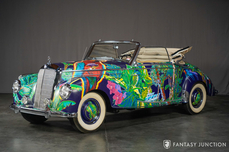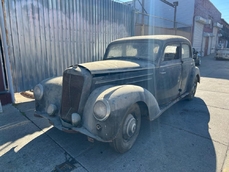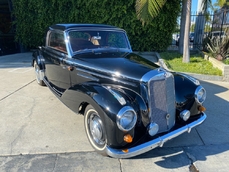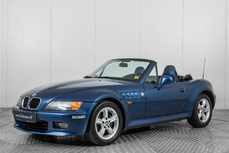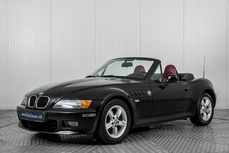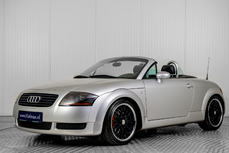Mercedes-Benz 220 W187 1952
General description :
Statige Mercedes-Benz 220 Limousine, een toonaangevende vijftiger jaren klassieker. Door de fabriek werd deze uitgeleverd op 21-12-1951 om voor het eerst in gebruik genomen te worden in Zwitserland op 15-02-1952. In 2005 werd de Benz geëxporteerd naar Duitsland om vervolgens aan een ingrijpende 'body off' restauratie en technische revisie onderworpen te worden. In 2008 werd de Benz toegevoegd aan de collectie van een Nederlandse verzamelaar die de auto tot op heden in bezit heeft gehad. Mercedes-Benz Classic heeft een geboorteakte aangeleverd waaruit blijkt dat onder de lange motorkap de originele krachtbron ligt met het juiste nummer. Ook de fraaie Maroon kleur op de carrosserie is de juiste. Als extra werd dit exemplaar uitgerust met verwarming. Het chroomwerk werd volledig vernieuwd en steekt prachtig af bij de donkere lak van de carrosserie. De passingen zijn allen zeer correct en de stevige portieren sluiten als spreekwoordelijk als een kluisdeur. De lichtbruine bekleding van het interieur werd ook onder handen genomen en het geheel is absoluut een lust voor het oog. Louter kwalitatief hoogwaardige materialen werden gebruikt en het afwerkingsniveau is van grote klasse. De zijruiten zijn omlijst met fraai houtwerk en voor de passagiers achterin zijn asbakjes aanwezig. In het zakelijke dashboard zijn de originele instrumenten aanwezig en dezen zijn keurig intact. De W187 was samen met de W186 de eerste Mercedes van na de tweede wereldoorlog die werden uitgerust met 6 cilinder motoren. De techniek voelt solide aan en is keurig up-to-date en daarmee ook prettig in gebruik. Een goed rijdende klassieker geschikt voor langere afstanden en regelmatig gebruik. Van de restauratie is een zeer compleet fotoverslag aanwezig. Prijswijzigingen, druk- en zetfouten voorbehouden. Altijd ruim 400 auto's op voorraad, check de actuele voorraad via http://www.hofman.nl. Volg ons ook op facebook.com/HofmanLeek #Cars&CoffeeLeek elke 2e zaterdag april t/m okt 10.00 tot 13.00 uur
Blauw kenteken, Tochtraampjes
https://www.hofman.nl/auto/220187/mercedes-benz-200-serie-220-limousine-w187/
1952 Mercedes-Benz 220 W187 is listed sold on ClassicDigest in Netherlands by Auto Dealer for €49900.
Car Facts
Car type : Car Make : Mercedes-Benz Model : 220 W187 Engine size : 2.2 Model Year : 1952 Sub type : Sedan Location : Netherlands
Sold
Seller Information
Sold
People who viewed this Mercedes-Benz 220 W187 also viewed similar Mercedes-Benz listed at ClassicDigest
Other cars listed for sale by this dealer
About Mercedes-Benz
In the annals of automotive history, the journey of Mercedes-Benz is a tale that unfolds with the ingenuity of its founding pioneers. In the year 1886, Karl Benz crafted the Benz Patent Motorwagen, a creation that would go down in history as the world's inaugural automobile. Unbeknownst to him, this moment marked the genesis of what would evolve into the most illustrious premium car manufacturer globally. The financial underpinning of this pioneering venture, interestingly, was provided by Karl Benz's wife, Bertha Benz, demonstrating a remarkable partnership that would set the tone for Mercedes-Benz's legacy.A parallel narrative emerged not far away, as Daimler-Motoren-Gesellschaft, founded by Gottlieb Daimler and Wilhelm Maybach, entered the scene. In 1901, they unveiled their automobile under the now-famous moniker "Mercedes," meaning "godsend" in Spanish. This name was bestowed upon the car at the behest of Emil Jellinek's daughter, the distributor for Daimler-Motoren-Gesellschaft. The wheels of innovation were set in motion.
Fast forward to 1926, a pivotal year that witnessed the merger of Daimler with Benz & Cie., culminating in the birth of Daimler-Benz. The amalgamation saw the adoption of "Mercedes-Benz" as the distinguished trademark for their automobiles, fusing the legacies of two visionary entities into one.
Contrary to perceptions of conservatism, the trajectory of Daimler-Benz unfolds as a chronicle of industry firsts. From the introduction of the honeycomb radiator to the float carburetor, and the pioneering implementation of four-wheel brakes in 1924, Daimler-Benz consistently pushed the boundaries of automotive innovation. The diesel-powered Mercedes-Benz 260 D in 1936 marked the inception of diesel engines in passenger cars. The iconic Mercedes-Benz 300SL Gullwing made history as the first car with direct fuel injection, albeit the Gutbrod's tiny 2-stroke engine can claim precedence.
Safety innovations became a hallmark, with Béla Barényi's patented safety cell design in the "Ponton"-models in 1951, featuring front and rear crumple zones. The W116 450SEL 6.9 saw the introduction of the Anti-Lock Brake system (ABS), another pioneering safety feature. From the first production airbags and beyond, the legacy of "firsts" continued to be etched into the fabric of Daimler-Benz.
Over its centennial journey, Mercedes-Benz has not merely produced cars but has sculpted automotive icons. The SSKL, 710 SSK Trossi Roadster, 770K Grosser, 540K Spezial Roadster, 300SL Gullwing, w100 600 Pullman, w111 280SE 3.5 Flachkühler, w113 230SL Pagoda, w109 300 SEL 6.3, and w201 2.3-16 Cosworth stand testament to the brand's commitment to engineering excellence.
The roaring Silver Arrows, or "Silberpfeile," including the W 25, W 125, W154, W165, and W196, created a legacy of dominance on the racetrack. These machines were not merely cars; they were expressions of precision, speed, and an indomitable spirit that left their competitors in the dust.
As Mercedes-Benz marches into the future, it does so not just as an automaker but as a custodian of a legacy, a torchbearer of innovation, and a beacon of automotive excellence. The road ahead is sure to witness the continued fusion of cutting-edge technology, timeless design, and an unwavering commitment to setting new standards in the world of automobiles.
One luminary figure who left an indelible mark was Béla Barényi, often heralded as the "father of passive safety" for his pioneering work in safety engineering. His patented safety cell design, featuring front and rear crumple zones, became a hallmark of Mercedes-Benz's commitment to occupant safety, setting new standards that reverberated throughout the automotive world.
Moving through the chronicles, the collaborative genius of Wilhelm Maybach, alongside Gottlieb Daimler, laid the foundation for Daimler-Motoren-Gesellschaft. Their innovations not only birthed the first Mercedes but established a culture of relentless pursuit of technological excellence that remains integral to Mercedes-Benz's DNA.
In the post-merger era of 1926, Ferdinand Porsche emerged as a prominent figure within Mercedes-Benz. His work on the Mercedes-Benz S-Type, a supercharged race car, garnered acclaim and set the stage for a legacy that extended far beyond the marque. Porsche's impact would later extend to his eponymous company, but his influence at Mercedes-Benz during those formative years was pivotal.
As the 20th century progressed, the legendary Rudolf Uhlenhaut emerged as a key figure. Uhlenhaut, an accomplished engineer and the driving force behind the iconic Silver Arrows, played a crucial role in Mercedes-Benz's dominance in motorsports. His engineering prowess and attention to detail were instrumental in creating some of the most formidable racing cars of the era.
In the latter half of the century, figures like Bruno Sacco, the head of design at Mercedes-Benz from 1975 to 1999, left an indelible imprint on the brand's aesthetic identity. Sacco's design philosophy, characterized by clean lines and timeless elegance, shaped iconic models like the W126 S-Class and the W201 190E, solidifying Mercedes-Benz's reputation for luxury and sophistication.
The narrative would be incomplete without acknowledging the contributions of engineers like Hans Scherenberg, whose leadership in the 1970s ushered in a new era of technological innovation at Mercedes-Benz. Scherenberg's tenure saw the development of groundbreaking technologies, including the Anti-Lock Brake system (ABS) and the introduction of airbags in production cars.


